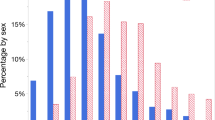Abstract
Emerging research in adults with HIV suggests negative body image may be found at a higher rate in this group. To date, few studies have examined body image in adolescents living with HIV. This exploratory study aimed to characterize body image perceptions among youth living with HIV. Adolescents (n = 143; age range 16–24 years; 69 % male) completed an Audio Computer Assisted Self-Interview Questionnaire that assessed body image, psychosocial, medical and sociodemographic information. Medical history and physical functioning information were abstracted from medical records. Results showed normative global body image on the Multidimensional Body Self-Relations Questionnaire-Appearance Scales. Some subscale elevations were observed; including decreased interest in self-care and appearance, as well as concerns with individual body areas. Overall, youth reported preference for own body shape on the Figure Rating Scale; however, 41 % of youth classified as “overweight” per CDC body mass index reported contentment with current body size. Further, 47 % of youth classified as “normal” weight desired to have larger body size. Youth identified as men who have sex with men most often reported desiring larger body size. Implications for clinical care are discussed.
Similar content being viewed by others
References
O’Brien KK, Bayoumi AM, Strike C, Young NL, King K, Davis AM. How do existing HIV-specific instruments measure up? Evaluating the ability of instruments to describe disability experienced by adults living with HIV. Health Qual Life Outcomes. 2010;8:88.
Plankey M, Bacchetti P, Jin C, et al. Self-perception of body fat changes and HAART adherence in the Women’s Interagency HIV Study. AIDS Behav. 2009;13(1):53–9.
Blashill AJ, Vander Wal JS. Components of body image in gay men with HIV/AIDS. Am J Mens Health. 2011;5(1):6–10.
Blashill AJ, Goshe BM, Robbins GK, Mayer KH, Safren SA. Body image disturbance and health behaviors among sexual minority men living with HIV. Health Psychol. 2014;33(7):677–80.
Mond J, van den Berg P, Boutelle K, Hannan P, Neumark-Sztainer D. Obesity, body dissatisfaction, and emotional well-being in early and late adolescence: findings from the project EAT study. J Adolesc Health. 2011;48(4):373–8.
CDC. Estimated HIV incidence in the United States, 2007–2010. HIV Surveillance Supplemental Report 2012;17(No. 4). Accessed 7 Dec 2015.
Cash TF. Body image: past, present, and future. Body Image. 2004;1(1):1–5.
Jones LR, Fries E, Danish SJ. Gender and ethnic differences in body image and opposite sex figure preferences of rural adolescents. Body Image. 2007;4(1):103–8.
Martyn-Nemeth P, Penckofer S, Gulanick M, Velsor-Friedrich B, Bryant FB. The relationships among self-esteem, stress, coping, eating behavior, and depressive mood in adolescents. Res Nurs Health. 2009;32(1):96–109.
Furnham A, Alibhai N. Cross-cultural differences in the perception of female body shapes. Psychol Med. 1983;13(4):829–37.
Altabe M. Ethnicity and body image: quantitative and qualitative analysis. Int J Eat Disorder. 1998;23(2):153–9.
Barroso CS, Peters RJ, Johnson RJ, Kelder SH, Jefferson T. Beliefs and perceived norms concerning body image among African-American and Latino teenagers. J Health Psychol. 2010;15(6):858–70.
Santos CP, Felipe YX, Braga PE, Ramos D, Lima RO, Segurado AC. Self-perception of body changes in persons living with HIV/AIDS: prevalence and associated factors. AIDS (London, England). 2005;19(Suppl 4):S14–21.
Martinez SM, Kemper CA, Diamond C, Wagner G. California Collaborative Treatment Group. Body image in patients with HIV/AIDS: assessment of a new psychometric measure and its medical correlates. AIDS Patient Care STDs. 2005;19(3):150–6.
Martinez J, Lemos D, Hosek S. Stressors and sources of support: the perceptions and experiences of newly diagnosed Latino youth living with HIV. AIDS Patient Care STDs. 2012;26(5):281–90.
Williamson I, Hartley P. British research into the increased vulnerability of young gay men to eating disturbance and body dissatisfaction. Eur Eat Disorders Rev. 1998;6:160–70.
Martins Y, Tiggemann M, Kirkbride A. Those speedos become them: the role of self-objectification in gay and heterosexual men’s body image. Pers Soc Psychol Bull. 2007;33(5):634–47.
Kelly JS, Langdon D, Serpell L. The phenomenology of body image in men living with HIV. AIDS Care. 2009;21(12):1560–7.
Tate H, George R. The effect of weight loss on body image in HIV-positive gay men. AIDS Care. 2001;13(2):163–9.
Pluhar E, McDonnell Holstad M, Yeager KA, et al. Implementation of audio computer-assisted interviewing software in HIV/AIDS research. J Assoc Nurses AIDS Care. 2007;18(4):51–63.
Cash TF, Pruzinsky T. Body images: development, deviance, and change. New York: The Guilford Press; 1990.
Stunkard AJ, Sorensen T, Schulsinger F. Use of the Danish adoption register for the study of obesity and thinness. In: Kety S, editor. The genetics of neurological and psychiatric disorders. New York: Raven; 1983. p. 115.
Pulvers KM, Lee RE, Kaur H, et al. Development of a culturally relevant body image instrument among urban African Americans. Obes Res. 2004;12(10):1641–51.
Centers for Disease Control and Prevention (CDC). About BMI for adults and teens. 2013; Available at: www.cdc.gov/healthyweight/assessing/bmi/. Accessed 12 August 2013.
Inc SI. SAS v9.3. 9.3 ed. Cary, NC, USA: SAS Institute Inc; 2012.
Yelland C, Tiggemann M. Muscularity and the gay ideal: body dissatisfaction and disordered eating in homosexual men. Eat Behav. 2003;4(2):107–16.
Carper TL, Negy C, Tantleff-Dunn S. Relations among media influence, body image, eating concerns, and sexual orientation in men: a preliminary investigation. Body Image. 2010;7(4):301–9.
Acknowledgments
The authors would like to acknowledge the contribution of clinical research assistant, Melissa Shenep, and psychology graduate student, Courtney Peasant, during the data collection phase of this project. We would also like to thank Kirk Knapp for his assistance with data abstraction from patient records.
Author information
Authors and Affiliations
Corresponding author
Rights and permissions
About this article
Cite this article
Wilkins, M.L., Dallas, R.H., Porter, J.S. et al. Characterizing Body Image in Youth with HIV. AIDS Behav 20, 1585–1590 (2016). https://doi.org/10.1007/s10461-015-1271-z
Published:
Issue Date:
DOI: https://doi.org/10.1007/s10461-015-1271-z




